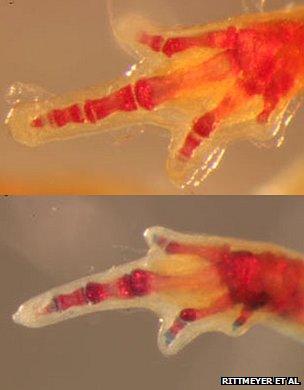World's smallest frog discovered
- Published

The tiny frog sits easily on a US dime, whose diameter is 18mm
A frog species that appears to be the world's smallest has been discovered in Papua New Guinea by a US-based team.
At 7mm (0.27 inches) long, Paedophryne amauensis may be the world's smallest vertebrate - the group that includes mammals, fish, birds and amphibians.
The researchers also found a slightly larger relative, Paedophryne swiftorum.
Presenting the new species in PLoS One journal, external, they suggest the frogs' tiny scale is linked to their habitat, in leaf litter on the forest floor.
Finding the frogs was not an easy assignment.
They are well camouflaged among leaves on the forest floor, and have evolved calls resembling those of insects, making them hard to spot.
"The New Guinea forests are incredibly loud at night; and we were trying to record frog calls in the forest, and we were curious as to what these other sounds were," said research leader Chris Austin from Louisiana State University in Baton Rouge, US.
"So we triangulated to where these calls were coming from, and looked through the leaf litter.
"It was night, these things are incredibly small; so what we did after several frustrating attempts was to grab a whole handful of leaf litter and throw it inside a clear plastic bag.
"When we did so, we saw these incredibly tiny frogs hopping around," he told BBC News.
Littering the leaves
The Paedophryne genus was identified only recently, and consists of a number of tiny species found at various points in the eastern forests of Papua New Guinea.

The tiny limbs of amauensis (top) and swiftorum are rendered translucent
"They're occupying the relatively thick leaf litter of tropical forest in low-lying parts of the island, eating incredibly small insects that typically are much smaller than insects that frogs eat," said Professor Austin.
"And they're probably prey for a large number of relatively small invertebrates that don't usually prey on frogs."
Predators may well include scorpions.
Intriguingly, other places in the world that also feature dense, moist leaf litter tend to possess such small frog species, indicating that amphibians are well placed to occupy this ecological niche.
Before the Paedophrynes were found, the title of "world's smallest frog" was bestowed on the Brazilian gold frog (Brachycephalus didactylus) and its slightly larger Cuban relative, the Monte Iberia Eleuth (Eleutherodactylus iberia). They both measure less than 1cm long.
The smallest vertebrates have until now been fish.
Adult Paedocypris progenetica, which dwells in Indonesian swamps and streams, measure 7.9-10.3 mm long.
Male anglerfish of the species Photocorynus spiniceps are just over 6mm long. But they spend their lives fused to the much larger (50mm long) females, so whether they should count in this contest would be disputed.
Paedophryne amauensis adults average 7.7mm, which is why its discoverers believe it how holds the crown.
The remote expanses of Papua New Guinea rank alongside those of Madagascar as places where hitherto undiscovered amphibian species are expected to turn up, as they are largely undeveloped and not well explored.
Follow Richard on Twitter, external
Related topics
- Published26 August 2010